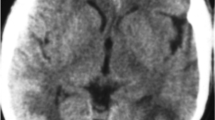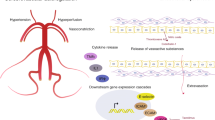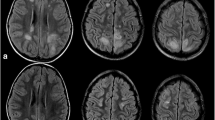Abstract
Background
Posterior Reversible Encephalopathy Syndrome (PRES) is a clinico-radiological entity characterized by headache, encephalopathy, visual disturbances, and seizures in association with reversible vasogenic edema on neuroimaging. Intracerebral hemorrhage associated with PRES (PRES-ICH) is generally considered an atypical finding.
Methods
Retrospective case series.
Results
Seven patients were identified with PRES-ICH, four males and three females. The presenting clinical symptoms included headache (2), encephalopathy (5), vision changes (2), seizures (2), and hemiparesis (1). The co-morbid conditions included acute renal dysfunction (3), solid organ transplantation (3), bone marrow transplant (1), use of calcineurin inhibitor agents (4), and pre-eclampsia (1). Neuroimaging revealed intraparenchymal hemorrhage in six patients and subarachnoid hemorrhage in one patient. Six of the seven patients with PRES-related ICH had underlying bleeding diathesis, including one patient who was anti-coagulated with a heparin drip. The mean platelet count was 82.1 × 103/μl (range, 4–232 × 103/μl), and the mean INR value was 2.18 (range, 0.9–6.7). Two patients died during the acute hospitalization. Among the five survivors, only two patients had good functional outcome (pre-defined as mRS ≤ 1).
Conclusion
In our series, the majority of patients with PRES-ICH (85%) had an underlying bleeding diathesis or coagulopathy. Although PRES is typically considered to have a favorable prognosis, the clinical outcome of PRES with associated ICH can be more variable.







Similar content being viewed by others
References
Hinchey J, Chaves C, Appignani B, Breen J, Pao L, Wang A, et al. A reversible posterior leukoencephalopathy syndrome. N Engl J Med. 1996;334:494–500. doi:10.1056/NEJM199602223340803.
Lee V, Widjicks E, Manno EM, Rabinstein AA. Clinical spectrum of reversible posterior leukoencephalopathy syndrome. Arch Neurol. 2008;65:205–10. doi:10.1001/archneurol.2007.46.
McKinney A, Short J, Truwit C, et al. Posterior reversible encephalopathy syndrome: incidence of atypical regions of involvement and imaging findings. AJR Am J Roentgenol. 2007;189:904–12. doi:10.2214/AJR.07.2024.
Bartynski WS, Boardman JF. Distinct imaging patterns and lesion distribution in posterior reversible encephalopathy syndrome. AJNR Am J Neuroradiol. 2007;28:1320–7. doi:10.3174/ajnr.A0549.
Schwartz R. Hyperperfusion encephalopathies: hypertensive encephalopathy and related conditions. Neurologist. 2002;8:22–34. doi:10.1097/00127893-200201000-00003.
Schwartz R, Jones K, Kalina P, et al. Hypertensive encephalopathy: findings on CT, MR imaging, and SPECT imaging in 14 cases. AJR Am J Roentgenol. 1992;159:379–83.
Morris B, Laningham F, Snadlund J, et al. Posterior reversible encephalopathy syndrome in children with cancer. Pediatr Blood Cancer. 2007;48:152–9. doi:10.1002/pbc.20703.
Servillo G, Striano P, Striano S, et al. Posterior reversible encephalopathy syndrome (PRES) in critically ill obstetric patients. Intensive Care Med. 2003;29:2323–6. doi:10.1007/s00134-003-1901-1.
Scwhartz R, Bravo S, Klufas R, et al. Cyclosporine neurotoxicity and its relationship to hypertensive encephalopathy: CT and MRI findings in 16 cases. AJR Am J Roentgenol. 1995;165(3):627–31.
Appignani BA, Bhadelia RA, Blacklow SC, et al. Neuroimaging findings in patients on immunosuppressive therapy: experience with tacrolimus toxicity. AJR Am J Roentgenol. 1996;166:683–8.
Truwit CL, Denarco CP, Lake JR, et al. MR imaging of reversible cyclosporine A-induced neurotoxicity. AJNR Am J Neuroradiol. 1991;12:651–9.
Small SL, Fukui MB, Bramblett GT, et al. Immunsuppression-induced leukoencephalopathy from tacrolimus (FK506). Ann Neurol. 1996;40:575–80. doi:10.1002/ana.410400406.
Tam CS, Galanos J, Seymour JF, et al. Reversible posterior leukoencephalopathy syndrome complicating cytotoxic chemotherapy for hematologic malignancies. Am J Hematol. 2004;77:72–6. doi:10.1002/ajh.20147.
Kitaguchi H, Tomimoto H, Miki Y, et al. A brainstem variant of reversible posterior leukoencephalopathy syndrome. Neuroradiology. 2005;47:652–6. doi:10.1007/s00234-005-1399-z.
Lamy C, Oppenheim C, Meder JF, et al. Neuroimaging in posterior reversible encephalopathy syndrome. J Neuroimaging. 2004;14:89–96. doi:10.1177/1051228403258161.
Schiff D, Lopes MB. Neuropathological correlates of reversible posterior leukoencephalopathy. Neurocrit Care. 2005;2:303–5. doi:10.1385/NCC:2:3:303.
Bartynski WS, Boardman JF. Catheter angiography, MR angiography and MR perfusion in posterior reversible encephalopathy syndrome. AJNR Am J Neuroradiol. 2007;29:447–55. doi:10.3174/ajnr.A0839.
Ducros A, Boukobza M, Porcher R, Sarov M, Valade D, Bousser MG. The clinical and radiological spectrum of reversible cerebral vasoconstriction syndrome: a prospective series of 67 patients. Brain. 2007;130:3091–101. doi:10.1093/brain/awm256.
Wartenberg KE, Parra A. CT and CT-perfusion findings of reversible leukoencephalopathy during triple-H therapy for symptomatic subarachnoid hemorrhage-related vasospasm. J Neuroimaging. 2006;16:170–5.
Amin-Hanjani S, Schwartz RB, Sathi S, Stieg PE. Hypertensive encephalopathy as a complication of hyperdynamic therapy for vasospasm: report of two cases. Neurosurgery. 1999;44:1113–6. doi:10.1097/00006123-199905000-00097.
Apollon KM, Robinson JN, Schwartz RB, Norwitz ER. Cortical blindness in severe preeclampsia: computed tomography, magnetic resonance imaging, and single-photon-emission computed tomography findings. Obstet Gynecol. 2000;95:1017–9. doi:10.1016/S0029-7844(00)00878-4.
Bartysnki WS. Posterior reversible encephalopathy syndrome, Part 2: controversies surrounding pathophysiology of vasogenic edema. AJNR Am J Neuroradiol. 2008;29:1043–9. doi:10.3174/ajnr.A0929.
Winn R, Youman J, Zweinenberg-Lee M, Muizelaar JP. Clinical pathophysiology of traumatic brain injury. In: Youman’s Neurological Surgery, 5th edn. Philadelphia: Saunders; 2004. p. 5039–64.
Bayliss W. On the local reactions of the arterial wall to changes of internal pressure. J Physiol. 1902;28:220–31.
Horbinski C, Bartynski WS, Carson-Walter E, et al. Reversible encephalopathy after cardiac transplantation: histologic evidence of endothelial activation, T-cell specific trafficking and VEGF expression. Am J Neuroradiol. 2008; Epub ahead of print.
Author information
Authors and Affiliations
Corresponding author
Rights and permissions
About this article
Cite this article
Aranas, R.M., Prabhakaran, S. & Lee, V.H. Posterior Reversible Encephalopathy Syndrome Associated with Hemorrhage. Neurocrit Care 10, 306–312 (2009). https://doi.org/10.1007/s12028-009-9200-5
Received:
Accepted:
Published:
Issue Date:
DOI: https://doi.org/10.1007/s12028-009-9200-5




